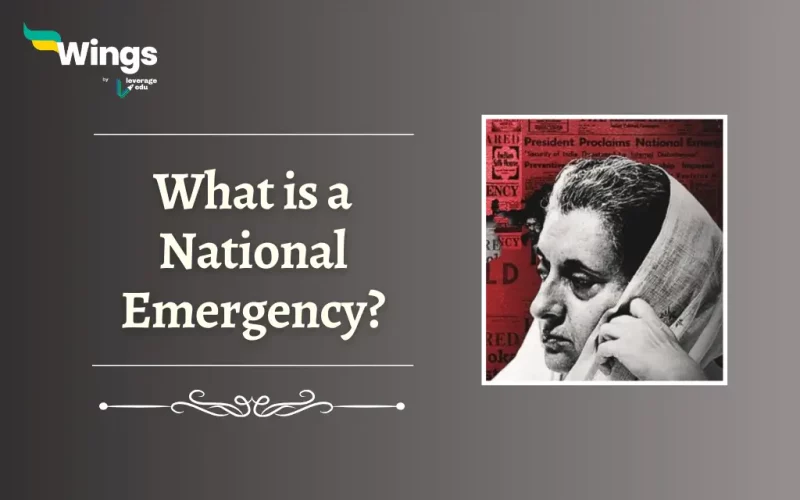A National Emergency is a situation in which a government is faced with a crisis or threat that requires immediate action to protect the nation and its citizens. It is a declaration made by the executive branch of the government. Moreover, it is mostly made by the President or Prime Minister, in response to an extraordinary event or circumstance. Under certain conditions of nationwide crisis, the President of India overtakes the governance of the country under the guidance of Cabinet Ministers. Under a state of National Emergency, the President can even overrule the Fundamental Rights of the citizens provided by the Constitution. In situations like war, external aggression or an armed rebellion a National Emergency is declared.
Table of Contents [show]

Definition of National Emergency
A National Emergency refers to a condition that poses a serious threat to the safety, security or well-being of a country and its people.
- Additionally, it grants the Executive branch additional powers and authority to respond effectively, usually bypassing standard procedures and protocols.
- This declaration allows for the allocation of resources, funds, and personnel to address the Emergency swiftly.
Also Read: All the Emergency Provisions in the Indian Constitution
Grounds of Declaration in India
National emergencies can arise from various factors like natural disasters, public health crises, terrorist attacks, civil unrest or economic instability. These events can significantly impact the nation and necessitate quick and decisive action.
- The declaration of a National Emergency enables the government to streamline its response and mobilize resources promptly.
- An Emergency can be declared by the President if he or she feels that the security of the country is threatened.
- The crux here is that under Article 352, the President can even declare a state of Emergency before the war, rebellion or aggression breaks out.
- The Emergency can be bifurcated as an External Emergency or Internal Emergency based on whether the grounds for declaring an emergency are war, external aggression or internal conflict.
Also Read: Unicameral and Bicameral Legislature: Meaning, Characteristics, Differences
Effects of the Emergency
The political system is torn apart in cases of National Emergencies as the power consolidates with the President. Here are some major impacts of such declarations:
- The coordination between the Centre and the State is disrupted.
- The Centre is then entitled to; give executive directions to the State, they can also make laws on state subjects and alter the revenue distribution.
- The tenure for Lok Sabha and state legislation can be extended by a year at a time.
- After the emergency is lifted, this provision will cease within 06 months.
- The Fundamental Rights of the citizen mentioned under Article 19 are automatically suspended.
- Other rights can also be suspended by order of the President and revived after the National Emergency is over.
Also Read: Right against Exploitation (Article 23-24)
Parliamentary Approval, Duration & Revocation of the Emergency
Within a month from the date of issuance, the National Emergency has to be approved by both parliamentary houses. In case the Lok Sabha is dissolved during this time before proclaiming an emergency, the Emergency Proclamation will gain a shelf life of 30 days after the new session is introduced, provided the Rajya Sabha has approved it in the meantime.
If passed the National Emergency stays for six months, after which it has to be renewed. The parliamentary houses will vote again for an Emergency. Moreover, if there is an extension required this can be continued indefinitely. In addition, both Houses need to vote on this with a special majority.
As for the revocation of the National Emergency, it can be revoked by the President at any point in time without needing approval from the Parliament. Also, if the Lok Sabha votes in simple majority and hence disapproves of the continuation of the Emergency, it has to be revoked with immediate effect.

Also Read: What is Representative Democracy?
Case of National Emergency in India
National Emergency was proclaimed in India in 1962, 1971 and 1975. This was introduced in the following conditions:
- Chinese aggression in the NEFA (From October 1962 to January 1968).
- Attack from Pakistan in December 1971.
- Due to internal disturbances, a third Emergency was declared in June 1975.
- Both the second and third Emergencies were revoked in March 1977.
Related Blogs
Lastly, we hope you liked our blog and gained an understanding of National Emergency. Moreover, you may even read more blogs and empower yourself with knowledge regarding Civics and Polity!
 One app for all your study abroad needs
One app for all your study abroad needs















 45,000+ students trusted us with their dreams. Take the first step today!
45,000+ students trusted us with their dreams. Take the first step today!
